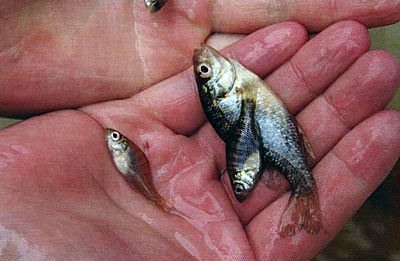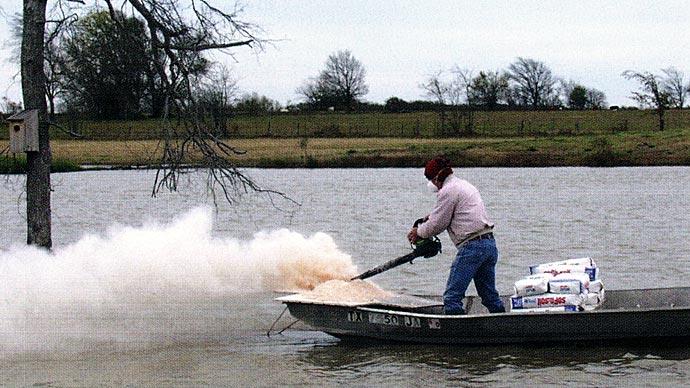
Water is not just born with some miracle fish-producing capacity. Most of our ponds fill by some derivative of rainwater, and after all, rainwater is very close to naturally distilled water. By its very definition, distilled water is pure water, without anything dissolved in it. Water vapor in the atmosphere condenses around a condensation nucleus, grows, becomes heavy, and falls as rain or snow. That new water has very few minerals dissolved in it. However, it is the minerals in surface water in all of their varying concentrations, and the characteristics they create, that really make our waters productive.
Good fish-producing water is either developed by nature over time, or influenced by humans trying to mimic nature by adding things to the water to make it more productive. Water can naturally pick up the minerals it takes to grow fish during interactions with parent materials like rock, percolation through soils and streams, and retention in ponds where the water interacts with the bottom. Generally, the longer these processes take, and the further the distance water travels, the greater the concentration of the minerals.
All rainwater is acidic, with a pH below the neutral value of 7. How acidic is rainwater? That depends on where you are in the country. The pH of most rain west of the Mississippi is in the low to mid-5s. East of the Mississippi the pH is in the low to mid-4s. Acidity of rainwater is caused by interaction with atmospheric carbon dioxide converted to the weak carbonic acid a rain makes its way to the ground. Fish prefer pH somewhere between 6.5-8.5. Trout like it a bit acidic on the low end, and tilapia like it more basic on the high end.
Ever hear this old mantra, "Water is the universal solvent"? Well, this old adage holds true here. As water moves down through our soils, over rocks, and into ground water, into creeks, ponds, lakes and rivers, it dissolves solids, which then become an integral part of the waters' make-up. These solids are the nutrients that grow fish. The first dissolved solid value that most of us identify with is hardness. Growing up, my family always associated hard water with high concentrations of iron. We had high-iron well water that dyed all my white t-shirts rust color. After going to college to study water and the critters that live in it, I realized that the rest of the world associates hardness with the concentration of calcium and magnesium ions. Without going into a lecture on water chemistry, think of these as salts much the same way that we think of table salt dissolved in water. Take a liter (L) of pure distilled water for example. It has no solids dissolved in it. Throw in 10 milligrams (mg) of NaCl (table salt) and you have 10 milligrams of NaCl per liter. Fish like 50-300 mg/L of hardness usually expressed in units of calcium carbonate. If the total hardness is 20-50 mg/L, that's a bit low and 0-20 mg/1 is limiting. Have I ever been to a pond with a hardness that low? Yes, it was a cold mountaintop pond, with a tiny watershed in a pine forest that was filled primarily from rain water. The water had no time to pick up hardness from the limited watershed. The hardness in this pond was below lOmg/L and had limited production. That's actually pretty common in areas of the United States where soils are primarily sandy and grow mostly pine trees.
If the hardness in your pond is low, it will it limit fish production. The fundamental elements are not there for the lower food chain (like zooplankton) to build their exoskeletons, and fish will not have enough calcium and magnesium in the water to nourish their own growth. I would recommend that you get your water tested to determine hardness, but one simple thing you can do is to take a clear glass bottle and scoop up pond water and look at it. If you can see a bunch of large bodied crustacean zooplankton like daphnia flitting about, you probably have enough hardness to produce them, ergo you probably have enough to produce some fish. If your pond has low hardness values, you can add crushed limestone to the inlet or around the shore in the swash zone, where wave action will work to dissolve the stone.
Using limestone to raise hardness has a second benefit, it will also raise the alkalinity, which is the power of water to buffer an acid, like that acidic rainwater. These are carbonate and bicarbonate ions that combine with hydrogen ions (acid formers), causing the water to resist changes in pH. The higher the alkalinity, the more resistant to pH changes. Water naturally picks up alkalinity in a similar way to hardness, percolating through soils as it moves toward the pond. If your pond is acidic, the alkalinity is probably low. Check it! Good alkalinity (50-300 mg/L), stabilizes the pond's pH, making it resistant to change. If you test the alkalinity of your pond and it is less that 20 mg/L, it is too low, and your pond will likely swing into the acidic range at some point. Adding lime or agricultural limestone will help. Remember that mountaintop lake? The alkalinity there was also near zero, resulting in a pH near 5. This was very low for the bass and bluegill the state was trying to grow there. The acidic rain fell in this mountaintop area and stayed acidic because the alkalinity was essentially zero. Those fish (a very hardy, stunted few) were essentially being grown in unproductive, acidic rainwater. That lake really could have benefited from a ton of agricultural lime per acre placed on the ice in the winter, for several winters in a row. Liming the lake would add alkalinity and raise the pH. The addition of several beaches of pulverized limestone placed along the inlets to the lake to keep the pH up while adding hardness in the process would have been another great benefit. The zooplankton population in this lake was depauperate, only small puny little rotifers formed a zooplanktonic base. Not a single, large bodied Cladocera (water flea) zooplankton has ever been observed in these waters. The hardness is too low and the fish are very small. A 10-year old Largemouth is only 12 inches long, because the mineral building blocks of life in the water, like hardness, are not in enough supply to start the food chain. No hardness results in an anemic food chain.
What about phosphorous? We hear lots of talk about fertilizing ponds. That usually means phosphorus, which is the key limiting nutrient needed for plant growth in many aquatic systems. In most waters, phosphorus is usually the nutrient that is in short supply, which limits phytoplankton production. Think green water. If a system has all the phosphorus it needs, the water is REALLY green, full of algae, and generally polluted, because it's choked with noxious blue green algae and is nitrogen limited. Phosphorus is usually measured in micrograms/L (or parts per billion), because most natural waters are low in this essential nutrient (like lO-lOOppb). Mother Nature naturally gets P into the water the same way as alkalinity and hardness, by dissolving solids as water percolates through the parent rock and soils. People can also contribute lots of phosphorus to a system through lake side septic systems and nearby agriculture, as most fertilizers have an abundance of phosphorus.
Here is the bottom line. If water arrives to your pond after traveling a great distance through soils and limestone rock, your natural pond probably has the building blocks of life necessary for a moderate fishery. If you are on a mountaintop, with a limited watershed in granite or some other hard weathering rock, you may have a nutrient poor aquatic system and you may need to raise the fertility of the pond to get the desired pH, alkalinity, and hardness necessary to produce the fish you want. The distance traveled, contact time, and concentrations of these minerals all factor in to the natural fertility of your pond's water. Want to change the natural fertility of your pond? Have your pond's water tested. My best advice is to contact a pond professional for some help.
Reprinted with permission from Pond Boss Magazine



